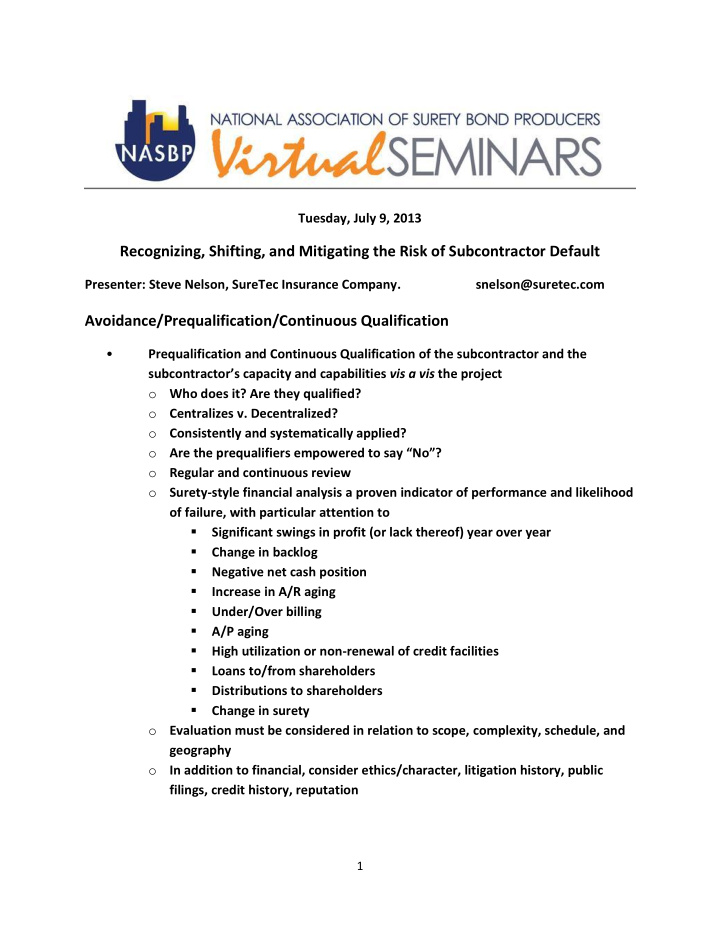



Tuesday, July 9, 2013 Recognizing, Shifting, and Mitigating the Risk of Subcontractor Default Presenter: Steve Nelson, SureTec Insurance Company. snelson@suretec.com Avoidance/Prequalification/Continuous Qualification • Prequalification and Continuous Qualification of the subcontractor and the subcontractor’s capacity and capabilities vis a vis the project o Who does it? Are they qualified? o Centralizes v. Decentralized? o Consistently and systematically applied? o Are the prequalifiers empowered to say “No”? o Regular and continuous review o Surety-style financial analysis a proven indicator of performance and likelihood of failure, with particular attention to Significant swings in profit (or lack thereof) year over year Change in backlog Negative net cash position Increase in A/R aging Under/Over billing A/P aging High utilization or non-renewal of credit facilities Loans to/from shareholders Distributions to shareholders Change in surety o Evaluation must be considered in relation to scope, complexity, schedule, and geography o In addition to financial, consider ethics/character, litigation history, public filings, credit history, reputation 1
• Attention to job cost breakdown, pay items, front end loading, percentage completion on draws---front end, and as work progresses Warning Signs • Recognize warning signs and act! o Delays in providing prequalification information, bonds, or insurance o Bid spread o Financial stress/availability of working capital/lines of credit o Overbilling o Increased change order activity o Competing creditors o Subcontractor/supplier payment notices, pre-lien, stop notices o Inquiries/directives from lenders/factoring companies/sureties o Labor/Supplier/Subcontractor turnover o Project level management/superintendent turnover o Death/disability of owner o Turnover of key management personnel (who often have a sense of impending problems and are looking for better opportunities) o Fluctuating workforce/change in crew size o Low productivity o Decline in quality of work o Decline in attention to safety issues o Difficulty with back office operations – paperwork, submittals, lien releases, change orders o Problems/disputes on other jobs o Negative feedback from other subcontractors o Understand the financial/operational weakness and tailor the tool to the problem ; i.e., joint checks won’t fix a bid bust or low productivity, increased retainage or withholding payment won’t help a cash flow problem o Manage a default to minimize exposure Credit Enhancements • Subcontract performance and payment bonds • Subcontractor Default Insurance • Letters of Credit 2
• Personal /Parental/Affiliate Guaranties • Third Party Guaranties • Major Supplier Guaranties • Pledge of Personal Property/Real Estate as collateral security • Bonded Sub-subcontractors with dual obligee riders • Hybrid risk sharing o Shared with owner, surety, or third parties if subcontract award is political, sole source, or “must hire” o shared with owner by negotiated right to charge some or all of subcontract overruns as cost of the work/change order Control of Subcontract Funding/Cash Flow • Dedicated GC employee oversight/mentoring – someone in the GC organization needs to take “ownership” of the subcontractor’s performance/success • Joint Checks • Funds Disbursement Control / Escrow • GC direct pay of suppliers, equipment, and/or labor • Increased Retainage • Reduced Retainage • Semi-monthly/weekly payroll advance • Greater attention to job cost breakdown, draw schedule, line items, front end loading, stored materials, and percentage completion on draws • Paying more than the subcontract amount, even when not justified by contract, may be better than a default Manage the Problem • Dedicated GC employee oversight/mentoring – someone in the GC organization needs to take “ownership” of the subcontractor’s performance/success • Establish processes to recognize warning signs, report, and react • Act quickly • Supplement vs. terminate • Document actions and preserve rights 3
Recommend
More recommend